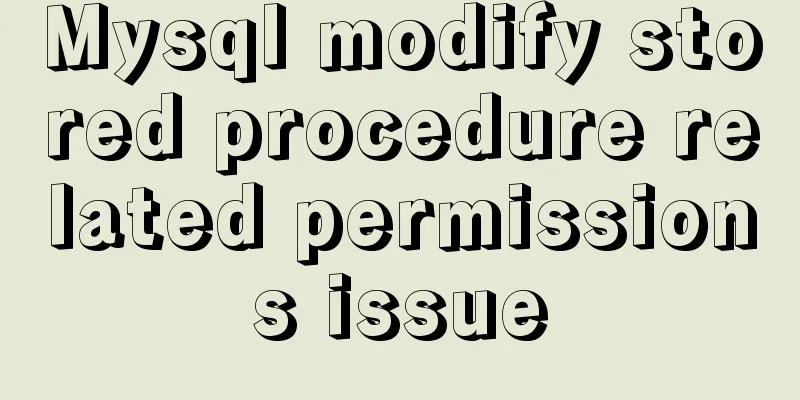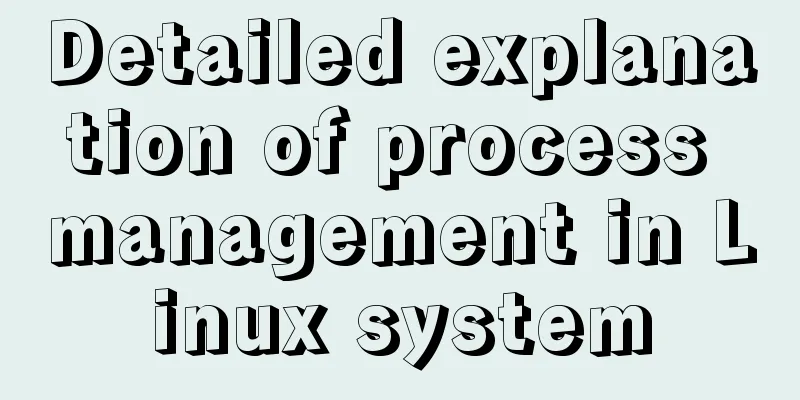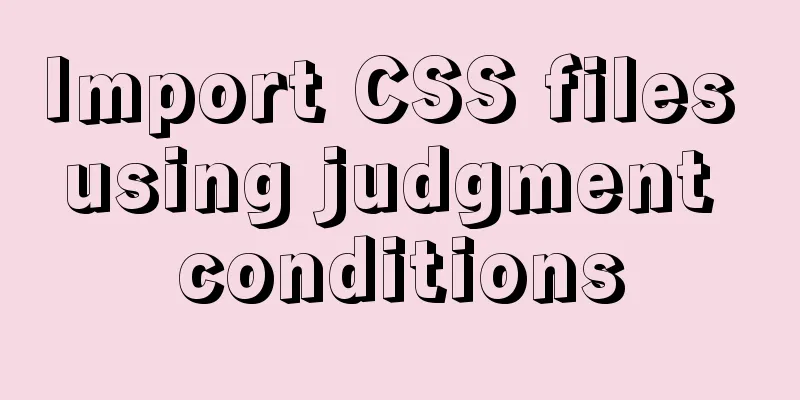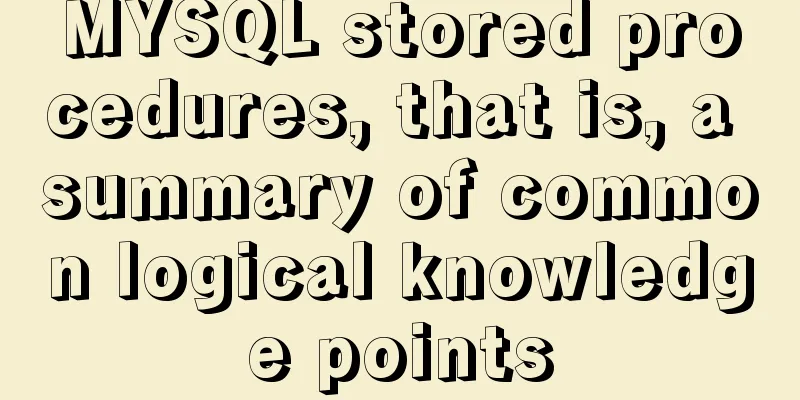Mysql modify stored procedure related permissions issue

|
When using MySQL database, you often encounter such a problem: the stored procedure defined by other users cannot be modified or deleted by another user. Normally, the definer of the stored procedure has the permission to modify and delete it, but other users must have the corresponding authorization, otherwise they cannot view or call it. In MySQL, user A creates a stored procedure. Now, another user B wants to modify the stored procedure created by A. The following records are generated based on this situation.
User A's permissions for the OTO3 library: mysql> show grants for 'a'@'%'; +---------------------------------------------------+ | Grants for a@% | +---------------------------------------------------+ | GRANT USAGE ON *.* TO 'a'@'%' | | GRANT ALL PRIVILEGES ON `OTO3`.* TO 'a'@'%' | +---------------------------------------------------+ 2 rows in set (0.00 sec) User B's permissions: mysql> show grants for 'swper'@'%'; +----------------------------------------------------------------------+ | Grants for swper@% | +----------------------------------------------------------------------+ | GRANT USAGE ON *.* TO 'swper'@'%' | | GRANT SELECT, UPDATE, DELETE, DROP, ALTER ON `OTO3`.* TO 'swper'@'%' | +----------------------------------------------------------------------+ 2 rows in set (0.00 sec) Log in to MySQL as user B; [root@mysql ~]# mysql -h10.0.10.110 -uswper -p123456 When checking the stored procedure list, it prompts that there is no permission: mysql> select `name` from mysql.proc where db = 'OTO3' and `type` = 'PROCEDURE'; ERROR 1142 (42000): SELECT command denied to user 'swper'@'mysql' for table 'proc' As root, add permission to view stored procedures to user B: mysql> grant select on mysql.proc to 'swper'@'%'; Query OK, 0 rows affected (0.00 sec) mysql> show grants for 'swper'@'%'; +----------------------------------------------------------------------+ | Grants for swper@% | +----------------------------------------------------------------------+ | GRANT USAGE ON *.* TO 'swper'@'%' | | GRANT SELECT, UPDATE, DELETE, DROP, ALTER ON `OTO3`.* TO 'swper'@'%' | | GRANT SELECT ON `mysql`.`proc` TO 'swper'@'%' | +----------------------------------------------------------------------+ 3 rows in set (0.00 sec) Go back to user B to view the stored procedure list: mysql> select `name` from mysql.proc where db = 'OTO3' and `type` = 'PROCEDURE'; +------------------------+ | name | +------------------------+ | proc_cs | +------------------------+ 1 row in set (0.00 sec) At this time, an additional mysql database is found, but only query permissions for mysql.proc are available: mysql> show databases; +--------------------+ | Database | +--------------------+ | information_schema | |OTO3| |mysql | +--------------------+ 3 rows in set (0.00 sec) There is only one table in the mysql library: proc mysql> use mysql mysql> show tables; +-----------------+ | Tables_in_mysql | +-----------------+ |proc| +-----------------+ 1 row in set (0.00 sec) You can also see the details of the stored procedure:
mysql> show create procedure proc_cs\G
*************************** 1. row ***************************
Procedure: proc_cs
sql_mode: STRICT_TRANS_TABLES,NO_AUTO_CREATE_USER,NO_ENGINE_SUBSTITUTION
Create Procedure: CREATE DEFINER=`a`@`%` PROCEDURE `proc_cs`()
BEGIN
Try to modify the configuration of the stored procedure: mysql> ALTER PROCEDURE proc_cs MODIFIES SQL DATA SQL SECURITY INVOKER; ERROR 1370 (42000): alter routine command denied to user 'b'@'%' for routine 'OTO3.proc_cs' In order to facilitate viewing, try to modify the stored procedure on the Navicat tool, and report the following permission problem when saving:
Try to add a stored procedure and report permission information:
This means that user b does not have the permission to modify the authorized stored procedure of OTO3; Try to call the following stored procedure as user B:
It is obvious that there is no permission to run. Try to delete the original user-defined stored procedure a, and the permission information will also be reported, as follows:
It can be seen that user B does not even have the permission to call the stored procedure. Here we first add the execution permission: Next, add a permission to execute the stored procedure: mysql> grant execute on OTO3.* to 'b'@'%'; Query OK, 0 rows affected (0.00 sec) mysql> show grants for 'b'@'%'; +-------------------------------------------------------------------------------+ | Grants for b@% | +-------------------------------------------------------------------------------+ | GRANT USAGE ON *.* TO 'b'@'%' | | GRANT SELECT, UPDATE, DELETE, DROP, ALTER, EXECUTE ON `OTO3`.* TO 'b'@'%' | | GRANT SELECT ON `mysql`.`proc` TO 'b'@'%' | +-------------------------------------------------------------------------------+ 3 rows in set (0.00 sec) Execute the stored procedure again and find that it succeeds;
Then add the permission to create and add stored procedures: mysql> grant CREATE ROUTINE on OTO3.* to 'b'@'%'; Query OK, 0 rows affected (0.00 sec) mysql> show grants for 'b'@'%'; +-----------------------------------------------------------------------------------------------+ | Grants for b@% | +-----------------------------------------------------------------------------------------------+ | GRANT USAGE ON *.* TO 'b'@'%' | | GRANT SELECT, UPDATE, DELETE, DROP, ALTER, EXECUTE, CREATE ROUTINE ON `OTO3`.* TO 'b'@'%' | | GRANT SELECT ON `mysql`.`proc` TO 'b'@'%' | +-----------------------------------------------------------------------------------------------+ 3 rows in set (0.00 sec) After adding the permissions above, you can create a stored procedure; CREATE DEFINER=`b`@`%` PROCEDURE `aaaa`() BEGIN #Routine body goes here... SELECT * from mysql.user; END But you cannot delete the ones you created.
Next, add a modification permission, which can also be deleted; mysql> grant alter ROUTINE on OTO3.* to 'b'@'%'; Query OK, 0 rows affected (0.01 sec) View User Permissions mysql> show grants for 'b'@'%'; +--------------------------------------------------------------------------------------------------------------+ | Grants for b@% | +--------------------------------------------------------------------------------------------------------------+ | GRANT USAGE ON *.* TO 'b'@'%' | | GRANT SELECT, UPDATE, DELETE, DROP, ALTER, EXECUTE, CREATE ROUTINE, ALTER ROUTINE ON `OTO3`.* TO 'b'@'%' | | GRANT SELECT ON `mysql`.`proc` TO 'b'@'%' | +--------------------------------------------------------------------------------------------------------------+ 3 rows in set (0.00 sec) After adding the alter ROUTINE permission above, you will have the delete permission for all OTO3 stored procedures [add, delete, and modify your own defined ones]. You can delete the stored procedures defined by others, but you cannot modify them. When modifying the stored procedures defined by others, the following prompt will appear:
Can you explain here where this SUPER permission is? By checking the user permissions, it turns out that here:
mysql> select * from mysql.user where user='b'\G
*************************** 1. row ***************************
Host: %
User: b
Select_priv: N
Insert_priv: N
Update_priv: N
Delete_priv: N
Create_priv: N
Drop_priv: N
Reload_priv: N
Shutdown_priv: N
Process_priv: N
File_priv: N
Grant_priv: N
References_priv: N
Index_priv: N
Alter_priv: N
Show_db_priv: N
Super_priv: N
Create_tmp_table_priv: N
Lock_tables_priv: N
Execute_priv: N
Repl_slave_priv: N
Repl_client_priv: N
Create_view_priv: N
Show_view_priv: N
Create_routine_priv: N
Alter_routine_priv: N
Create_user_priv: N
Event_priv: N
Trigger_priv: N
Create_tablespace_priv: N
ssl_type:
ssl_cipher:
x509_issuer:
x509_subject:
max_questions: 0
max_updates: 0
max_connections: 0
max_user_connections: 0
plugin:mysql_native_password
authentication_string: *CCB4F88E945E0E14F9BEB093EB797BB0BDBFA175
password_expired: N
password_last_changed: 2017-03-06 11:37:35
password_lifetime: NULL
account_locked: N
1 row in set (0.00 sec)
Try adding the SUPER permission: mysql> grant SUPER on OTO3.* to 'b'@'%'; ERROR 1221 (HY000): Incorrect usage of DB GRANT and GLOBAL PRIVILEGES mysql> grant SUPER on *.* to 'b'@'%'; Query OK, 0 rows affected (0.00 sec) This permission cannot be executed on the specified database because SUPER is a global permission for the entire MySQL. mysql> show grants for 'swper'@'%'; +--------------------------------------------------------------------------------------------------------------+ | Grants for swper@% | +--------------------------------------------------------------------------------------------------------------+ | GRANT SUPER ON *.* TO 'swper'@'%' | | GRANT SELECT, UPDATE, DELETE, DROP, ALTER, EXECUTE, CREATE ROUTINE, ALTER ROUTINE ON `OTO3`.* TO 'swper'@'%' | | GRANT SELECT ON `mysql`.`proc` TO 'swper'@'%' | +--------------------------------------------------------------------------------------------------------------+ 3 rows in set (0.00 sec) When you check again, you will find that Super_priv: Y has changed; then modify the stored procedure defined by others; mysql> select * from mysql.user where user='b'\G Checking all databases, I found that only one proc table in the mysql database had read permissions. SUPER was not as powerful as I thought. mysql> show databases; +--------------------+ | Database | +--------------------+ | information_schema | |OTO3| |mysql | +--------------------+ 3 rows in set (0.00 sec) If you look closely, you will find the execution statement: mysql> select * from mysql.user where user='b'\G We can see that there are Create_routine_priv: N and Alter_routine_priv: N. These two permissions are obviously permissions for stored procedures. Can we use these two permissions without SUPER? Reclaim this SUPER permission; mysql> revoke super on *.* from 'b'@'%'; Query OK, 0 rows affected (0.01 sec) Add Alter_routine_priv, Create_routine_priv mysql> grant alter routine,create routine on *.* to 'b'@'%'; Query OK, 0 rows affected (0.00 sec) View user b's permissions mysql> show grants for 'b'@'%'; +--------------------------------------------------------------------------------------------------------------+ | Grants for b@% | +--------------------------------------------------------------------------------------------------------------+ | GRANT CREATE ROUTINE, ALTER ROUTINE ON *.* TO 'b'@'%' | | GRANT SELECT, UPDATE, DELETE, DROP, ALTER, EXECUTE, CREATE ROUTINE, ALTER ROUTINE ON `OTO3`.* TO 'b'@'%' | | GRANT SELECT ON `mysql`.`proc` TO 'b'@'%' | +--------------------------------------------------------------------------------------------------------------+ 3 rows in set (0.00 sec) It is found that the same permission problem is still reported:
After executing the above permissions, you can see other system libraries: [For example, the sys library also has stored procedures, because these two permissions are global] mysql> show databases; +--------------------+ | Database | +--------------------+ | information_schema | |OTO3| |mysql | | performance_schema | |sys| | test | +--------------------+ 6 rows in set (0.00 sec) These two permissions are more powerful. They can even see, modify, and delete stored procedures in the system library sys, which is very dangerous. We decided to revoke the permissions again. create routine, alter routine; mysql> revoke create routine,alter routine on *.* from 'b'@'%'; It is safer to use the SUPER privilege. The following conclusions were drawn from the above tests:
In short, user A defines a stored procedure in the database OTO3. Now he wants to use user B to execute and modify the stored procedure. He needs to add the following permissions to user B: GRANT SELECT ON MYSQL.PROC TO 'B'; GRANT EXECUTE, CREATE ROUTINE, ALTER ROUTINE ON `OTO3`.* TO 'B'; GRANT SUPER ON *.* TO 'B'; So the most basic permissions for user B are: mysql> show grants for 'b'@'%'; +----------------------------------------------------------------------------------------+ | Grants for b@% | +----------------------------------------------------------------------------------------+ | GRANT SUPER ON *.* TO 'b'@'%' | | GRANT SELECT, ALTER, EXECUTE, CREATE ROUTINE, ALTER ROUTINE ON `OTO3`.* TO 'b'@'%' | | GRANT SELECT ON `mysql`.`proc` TO 'b'@'%' | +----------------------------------------------------------------------------------------+ 3 rows in set (0.00 sec) At this point, it is very clear that another user has the right to modify the stored procedures defined by others in MySQL. If the stored procedure is not called as another user, you can use root privileges to change the definer of the stored procedure; this is equivalent to changing the owner's privileges in Linux; update mysql.proc set DEFINER='b'@'%' WHERE NAME='proc_cs' AND db='OTO3'; This is the end of this article about the issue of permissions related to MySQL modified stored procedures. For more relevant MySQL stored procedure permissions content, please search for previous articles on 123WORDPRESS.COM or continue to browse the following related articles. I hope everyone will support 123WORDPRESS.COM in the future! You may also be interested in:
|
<<: Summary of how JS operates on pages inside and outside Iframe
Recommend
The use of v-model in vue3 components and in-depth explanation
Table of contents Use two-way binding data in v-m...
Learn javascript iterator
Table of contents Introduction What does an itera...
Detailed explanation of Vue form binding and components
Table of contents 1. What is two-way data binding...
Solve the abnormal error when building vue environment with webpack
Table of contents First, configure package.json T...
How to quickly insert 10 million records into MySQL
I heard that there is an interview question: How ...
Docker enables seamless calling of shell commands between container and host
As shown below: nsenter -t 1 -m -u -n -i sh -c &q...
JavaScript implementation of magnifying glass details
Table of contents 1. Rendering 2. Implementation ...
How to change MySQL character set utf8 to utf8mb4
For MySQL 5.5, if the character set is not set, t...
Detailed analysis of binlog_format mode and configuration in MySQL
There are three main ways of MySQL replication: S...
The whole process of installing and configuring Harbor1.7 on CentOS7.5
1. Download the required packages wget -P /usr/lo...
Design of pop-up windows and floating layers in web design
In the trend of gradual transition from tradition...
Vue custom components use event modifiers to step on the pit record
Preface Today, when I was using a self-written co...
MySQL permissions and database design case study
Permissions and database design User Management U...
A brief discussion on several advantages of Vue3
Table of contents 1. Source code 1.1 Monorepo 1.2...
Detailed explanation of Vue.js directive custom instructions
Customize a demo command The syntax of Vue custom...










